|
|
If you are reading these rules for the first time, ignore the text along the right hand side. These rules serve as a summary to help you quickly familiarize yourself with the game.
Show
→ summary only
→ detailed version only
→ both summary and detailed version

These rules have been adapted to the online play and have been a bit abridged. The redbordered boxes (like this one)
with the text "Clarification:" mark the rules that had been clarified by the game designer.
Base game rules of both editions are almost identical. The differences are listed here.
In 1703, Czar Peter the Great founded Saint Petersburg, which soon became known
as "Paris of the East". The Winter Palace, the Hermitage, the Church
of the Resurrection of Jesus Christ, and many other buildings even today beckon
visitors from all over the world. But Saint Petersburg was only a part of his
numerous activities. Peter reformed the whole of the Russian Empire and brought
it from the Middle Ages to a par with Europe of that time. To accomplish this,
he needed a new administration and brought the aristocrats under his control.
This was also a golden time for the workers as their skills were much needed
to reform and build the new Russia. The players will take important roles in
the building of SAINT PETERSBURG. The players acquire workers, buildings, and
aristocrats, and place them in their play areas. These earn the players money,
points, or both during the game. For the aristocrats, players can earn additional
points at the end of the game. The player who is best able to manage his meager
money supply and buy the right things at the right times, will win the game.
Preparation
-
Shuffle the
cards by each group separately (workers, buildings, aristocrats, and trading
cards). Place each group face down in a stack on the appropriate space on
the board.
-
Each player
takes 25 rubles. The players keep their money secret from others
during the game and may never tell others how much they have. This has been changed for online play: money is visible to all players!
- The starting stones are distributed randomly such that each player has at least one and no player more than two.
- The starting cards are taken from the workers stack and placed face up in the upper card row. For each player two cards are drawn.
-
The game begins with the first worker phase.
Before we show you how the game is played, let’s have a look at the cards and how they are designed.
How are the cards designed?
All cards are designed in a similar style, which means that their individual elements are always found in the same
locations. No one card possesses every element. Some elements are very common, while others can only be found on
a couple of cards.
The elements are: Cost, Income, Special Function, and Worker Symbol.
Cost
Each card, regardless of type, has a Cost printed in the upper left hand corner.
Income and Special Functions
Each card, regardless of type, has a separated region in the lower third. This region is where you will find a card’s
Income and potentially its Special Functions.
Income: During the corresponding scoring, the indicated income is
provided. This can include rubles (left) and/or victory points (right).
Special Functions: For a complete
listing, see here
Worker symbols
Workers and worker exchange cards have a Worker Symbol printed on the left, below their cost.
Each group of workers has a corresponding Worker Symbol. There
are 5 different groups  . There are also
exchange cards with the corresponding Worker Symbols. . There are also
exchange cards with the corresponding Worker Symbols.
Exception: The Czar & carpenter, which includes all Worker Symbols.
SAINT PETERSBURG is played over several rounds, each round consists of
4 phases in the following order:
- the worker phase
-
the building phase
-
the aristocrat phase
-
the trading card phase
Each phase consists of the following (in the order shown):
-
The actions:
the players acquire cards and play these on
the table, add them to their hands, or play them from their hands to the
table.
-
The scoring
-
The new cards are placed on the board.
SAINT PETERSBURG is played over several rounds (7-10). Each round consists of
4 phases (always in the following order):
- the worker phase
-
the building phase
-
the aristocrat phase
-
the trading card phase
Then the players start the next round with the worker phase.
Each phase consists of the following (in the order shown):
-
The actions:
the players acquire workers, buildings, and aristocrats. They play these on
the table, add them to their hands, and play them from their hands to the
table. This is the main part of the phase.
-
The scoring:
the players score their workers or buildings or aristocrats
-
The new cards:
the administrator places new cards on the board.
All four phases play in this way, except for the trading card phase, where there is no scoring.
1. The actions
On a player's turn, he must take 1 of the following 4 actions: either
-
buy: 1 worker or 1 building or 1 aristocrat or
-
add to his hand: 1 worker or 1 building or 1 aristocrat or
-
play from his hand: 1 worker or 1 building or 1 aristocrat or
- pass
The starting player
for a phase always takes the first action of the phase.
Next, the other players follow in clockwise order and each must
always take one of the 4 allowed actions.
After all players have taken an action,
it is again the starting player's turn and the above is repeated.
When all players pass in player order, the actions are done and
the phase moves to scoring.
On a player's turn, he must take 1 of the following 4 actions: either
-
buy: 1 worker or 1 building or 1 aristocrat or
-
add to his hand: 1 worker or 1 building or 1 aristocrat or
-
play from his hand: 1 worker or 1 building or 1 aristocrat or
- pass
The 4 actions in detail
buy
The player buys 1 card, either 1 worker or 1 building or 1 aristocrat.
Primarily, the workers earn the players money, the buildings earn the players
points, and the aristocrats can earn the players both. A player can buy a
card from either card row on the board. When a player buys a card, he pays
the cost to the bank, and immediately places the card face up in his play
area. The players should group the cards in his play area with all workers
together, all buildings together, and all aristocrats together.
Note: obviously,
players may only buy worker cards in the first worker phase as there are no
other cards on the board. Soon, however, cards from the other groups will
be available on the board.
add to his hand
The player takes 1 card from either card row and adds it to his hand. He does
not pay for this card. A player can have at most 3 cards in his hand and keeps
them secret from the others. At game end, each card in a player's hand scores
minus 5 points.
play from his hand
The player places 1 card from his hand face up in his play area. He now pays
the cost of the card to the bank. He can play a card he has added to his hand
earlier in this round or from a previous round.
pass
A player must pass when he cannot or chooses not to take other actions.
Note:
a player, who has passed, may pass again or take a normal action (buy, add
to his hand, or play from his hand) on his next turn.
The starting player
for a phase always takes the first action of the phase. For example, the first
action in the worker phase is taken by the player with the starting player marker
for the worker. Next, the other players follow in clockwise order and each must
always take one of the 4 allowed actions.
After all players have taken an action,
it is again the starting player's turn. He may take the same action as before
or a different action as he chooses. As before, the others follow in clockwise
order.
When all players pass in player order (the first pass need not be the
starting player), the actions are done and the phase moves to scoring.
Remember:
-
A player can
buy 1 card or add a card to his hand or play a card from his hand; otherwise
he must pass.
-
A player can
buy or add to his hand any of the cards on the board (upper or lower row)
in any phase. He can, for example, buy a fur trapper in the building phase,
if he wants and it is available.
-
A player can
play any card in his hand in any phase. He can, for example, play (and pay
for) a shepherd in the aristocrat phase, if he wishes.
2. The scoring
In each phase, players score their cards they have in their play areas,
corresponding to the phase.
-
workers in the worker phase
-
buildings in the building phase
-
aristocrats in the aristocrat phase
There is no scoring in the trading card phase
The players earn
money (from the bank) or points or both.


Example: The Mistress of Ceremonies earns 6 rubles and 3 points.
What is scored?
The players score either the workers or the buildings or the aristocrats that
they have in their play areas.
When are which cards scored?
In the worker phase,
the players score only their workers; in the building phase, they score only their
buildings; and in the aristocrat phase, they score only their aristocrats. All
cards of the appropriate group are scored, including those played in the current
round and those played in previous rounds.
What do the
players earn during scoring?
The players earn
money or points or both (or nothing, if a player has no cards of the kind being
scored). The players get money earned from the bank.
3. The new cards
At the end of each phase, cards are added from the card
stack of the next phase
to the board until there are a total of eight on the board.
During the actions,
the players take cards from the board. At the end of each phase, cards are added
to the board until there are a total of eight on the board (regardless
of the number of players - always 8!). To do this:
- New cards are taken from the next card stack.
- New cards are placed only in the upper card row.
The trading card phase runs differently than the others.
-
There is no scoring.
The players take actions in the trading card phase just like the
other phases.
-
After the actions,
all remaining cards from the lower card row are discarded.
- All the remaining cards from the upper card row are moved to the lower card row.
- Next, worker cards are added to the upper row, making a total of 8 cards on the board.
-
The players
give their starting player markers to their left neighbors.
The round is now
ended. The next round begins as before with the worker phase.
The trading card
phase runs differently than the others.
-
In the trading
card phase, there is no scoring. No player earns money or points. To emphasize
this, there are no money or point symbols on the space for trading cards on
the board. The players take actions in the trading card phase just like the
other phases.
-
After the actions,
all remaining cards from the lower card row are discarded.
Note:
after the first round, there can be no cards in the lower row. It will only
be in later rounds that cards may be in the lower row.
- All the remaining cards from the upper card row are moved to the lower card row.
- Next, worker cards are added to the upper row, making a total of 8 cards on the board.
-
The players
give their starting player markers to their left neighbors, changing the starting
players for the next round.
The round is now
ended. The next round begins as before with the worker phase. In this way, the
game continues until game end.
When last card of a stack is placed on the board, play continues through all
phases of this round. After the round ends, the game ends and the final scoring
follows.
The final scoring
-
Points for the aristocrats as shown in the picture:

-
1 point for each full 10 rubles
-
For each card a
player still has in his hand, he scores -5 points.
The player with
the most points is the winner.
If players tie, the one among them with the most
money is the winner.
When last card of a group (the last worker, the last building, the last
aristocrat, or the last trading card) is placed on the board, play continues through all
phases of this round. After the round ends, the game ends and the final scoring
follows. If there are not enough cards to fill 8 spaces, he places as many as
there are.
The final scoring
In the final scoring,
each player earns points for the aristocrats in his play area and for the money
he has left.
 The points for the aristocrats:
The points for the aristocrats:
For each different type of aristocrat a player earns points (duplicate aristocrats do not count).
The points depend on the number of different types of aristocrats as shown in the picture.
The points for the money:
For each full 10 rubles, a player earns 1 point.
Minus points:
For each card a
player still has in his hand, he scores -5 points (-5, -10, or -15).
The player with
the most points is the winner.
If players tie, the one among them with the most
money is the winner.
There are 4 possible
ways to reduce the cost of a card:
-
When the player
already has the same card in his play area, he pays
1 less ruble for each copy he has.
-
Cards bought from the lower card row cost 1 ruble less than the normal
cost.
-
When the player
has a gold smelter in his play area, he pays 1 ruble less for each red card
he buys.
-
When a player
has a carpenter workshop in his play area, he pays 1 ruble less for each blue
card he buys.
All cost reductions
are cumulative.
A player must always pay at least 1 ruble to buy a card.
There are 4 possible
ways to reduce the cost of a card:
-
When the player
already has the same card (or several of the same card) in his play area, he pays
1 less ruble for each copy he has.
-
When the player
buys a card from the lower card row, he pays 1 ruble less than the normal
cost.
-
When the player
has a gold smelter in his play area, he pays 1 ruble less for each red card
he buys (after he has the gold smelter).
-
When a player
has a carpenter workshop in his play area, he pays 1 ruble less for each blue
card he buys after he has it.
All cost reductions
are cumulative.
Example: A player buys the theater from the lower card row
(-1 ruble), he already has 1 theater in his play area (-1 ruble), and he has
the carpenter workshop (all blue cards -1 ruble). He pays 20 rubles minus 3
rubles = 17 rubles. The theater costs 17 rubles.
A player can never
take money when the cost is less than 0. In fact, he can never pay just 0. A
player must always pay at least 1 ruble to buy a card, even when its cost is
0 or less!
The stack of trading cards has 10 workers, 10 buildings, and 10 aristocrats.
The front side makes it clear which group the card belongs to.
When a player buys
a trading card or places a trading card from his hand in his play area, he must
displace an already placed card of the same color from his play area and places
the displaced card on the discard space.
Each blue trading
card can displace any already placed building. Each red trading card can displace
any already placed aristocrat.
The green
trading cards can only replace workers with the corresponding symbol.
A trading card cannot displace another trading card.
What does a
trading card cost?
-
When the trading
card is more expensive than the card it displaces, the player must pay the
difference between the two.
-
Otherwise he pays 1 ruble.
-
All normal cost
reductions apply to trading cards.
The stack of trading cards has 10 workers, 10 buildings, and 10 aristocrats. To distinguish them,
they have all three colors on their backs and the color of one of the 3 groups
on the front. The front side makes it clear which group the card belongs to.
It also has the cost and reward numbers in the appropriate places.
When a player buys
a trading card or places a trading card from his hand in his play area, he must
do the following:
-
He must displace
an already placed card of the same color from his play area. He cannot simply
place a trading card in his play area as he does the other cards. He places
the displaced card on the discard space.
Example: the player discards the
lumberjack to place the carpenter workshop.
-
Each blue trading
card can displace any already placed building. Each red trading card can displace
any already placed aristocrat.
-
With the green
trading cards: a carpenter workshop can only displace a lumberjack, a gold
smelter can only displace a gold miner, a weaving mill can only displace
a shepherd, a fur shop can only displace a fur trapper, and a wharf can only
displace a ship builder. Players can recognize the pairs by the like symbols
in the upper right.
-
A trading card cannot displace another trading card.
What does a
trading card cost?
-
When the trading
card is more expensive than the card it displaces, the player must pay the
difference between the two.
-
When the trading
card is the same or cheaper than the card it displaces, the player must pay
1 ruble.
All normal cost
reductions apply to trading cards.
Example: the player displaces the market
with the St Issac's Cathedral. The difference in cost is 10 rubles. The player
takes the card from the lower card row (-1 ruble). He also has the carpenter
workshop, saving him another ruble. Thus, he can subtract 2 rubles from the
normal cost of 10 rubles and pay only 8 rubles. He places the market on the
discard space.

Mariinskij Theater (1st edition)
The aristocrats love theater: When scoring the buildings, the player earns
1 ruble for each aristocrat that he has in his play area.
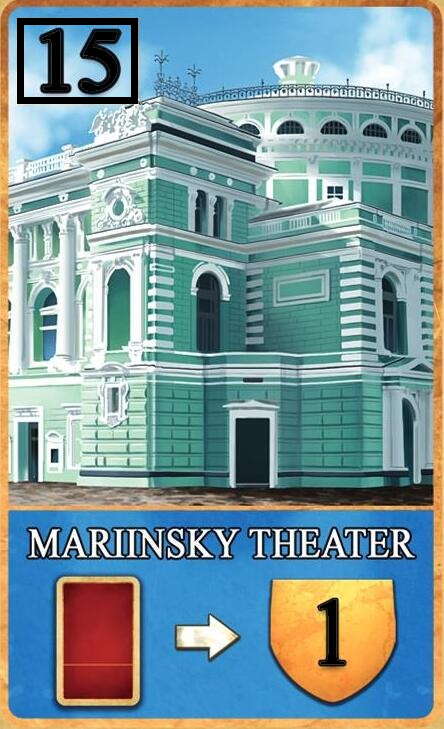
Mariinskij Theater (2nd edition)
Costs 15 rubles. During
building scoring,
you score 1 victory
point for each noble
(red card) in your
play area.


Warehouse
Good, but dangerous: The player can have up to 4 cards in his hand.

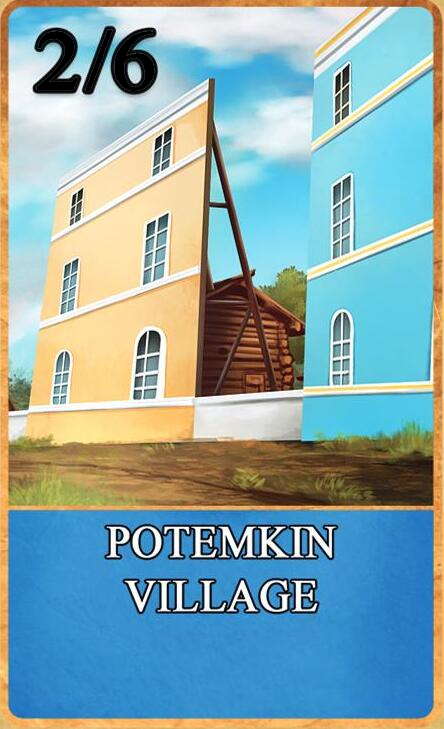
Potjomkin's Village
The virtual village pays for itself: The player pays 2 rubles when he buys/places
the card. If he displaces the card with a trading card, it is worth 6 rubles.

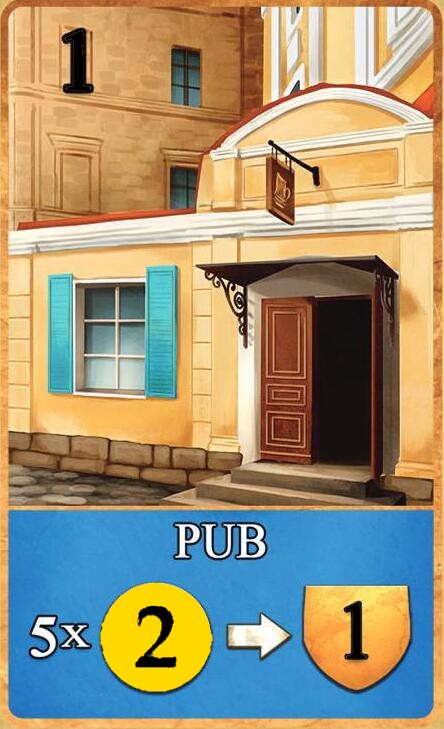
Pub
Don't spend
too much: Immediately after each scoring of buildings, the player can buy up
to 5 points. Each point costs 2 rubles. (The player cannot "buy" 2
rubles for 1 point.)
Clarification: If two players have pubs, they make decisions starting with the one holding the starting player marker of the building phase.

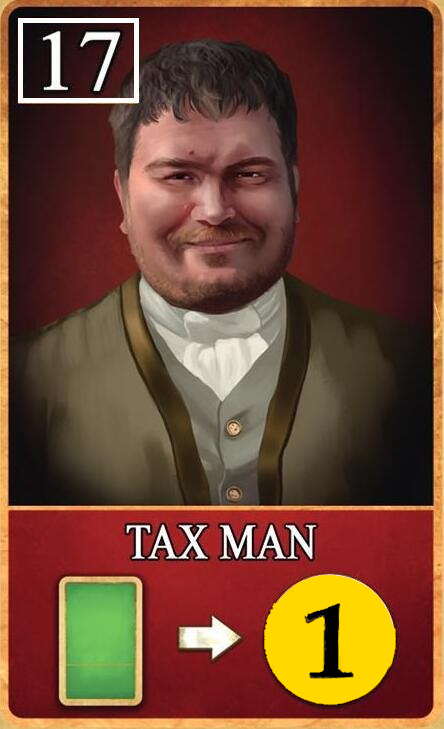
Tax Man
Unattractive
job, but important: When scoring the aristocrats, the player earns 1 ruble for
each worker that he has in his play area.


Czar and Carpenter
Czar Peter can do it all: He can be displaced by any green trading card.

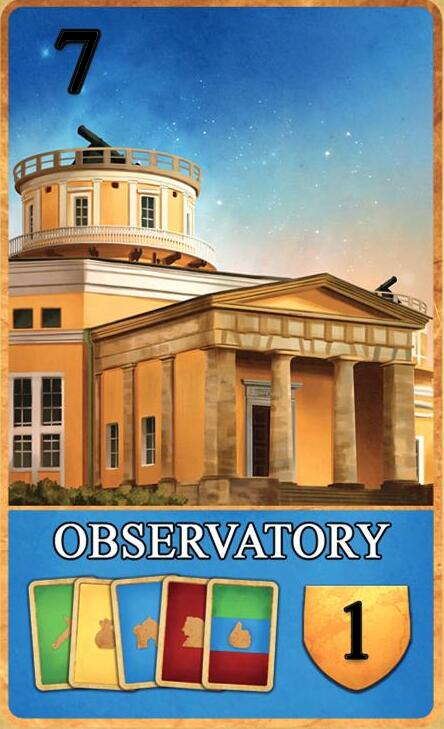
Observatory
1 secure point or a good opportunity: The observatory is worth 1 point in scoring
if the player does not use the following: once, during the blue actions, he
may draw the top-most card from the stack of his choice (it may not be the last
card in the stack). He must immediately either buy and place the card or add
the card to his hand or discard the card. In each case, he turns the observatory
card over and will score not points for it. To begin the next round, he turns
it face-up so it is again available for scoring or its special ability.
-
In the first worker phase, each player should buy 2 workers! A player with fewer than two
workers will find himself running after his opponents with two.
Buying the first 2 workers is mandatory. Workers have the best cost/reward ratio.
-
Expensive cards
have higher reward ratios. 1 point with a market costs 5 rubles, 1 point with
a customs house costs only 4 rubles, etc. Thus, a player can do well to save
money to buy more expensive cards later.
-
In the first
building phase, the question will arise: should a player invest in an expensive
building? Such a building always earns the player many points in the scoring
of buildings. However, such a player will have little money for a while and
that can be very dangerous.
-
Trading cards
are mostly good. Players should try to save some money for the trading card
phase. But, players should be careful not to spend all their money in this
phase as there is no scoring and no money gained in the phase. Without money,
a player will be unable to buy the new worker cards that will be available
in the first phase of the next round.
-
When a player
is faced with the decision to buy a card or add it to his hand, in addition
to the points and/or money the card will earn the player, he should also consider
the following: when a card is removed from the board, it makes room for a
new card in the next phase. Does the player want this? When the player is
the next starting player, he has little interest in leaving many places for
new cards. However, a player sitting far from the starting player may want
more new cards available.
-
Adding a card
to his hand is often important for a player. In this way, a player can hold
the card for a later turn when he has the money to pay for it. Of course,
it can be dangerous to speculate too much, as nothing is more painful than
for a player to have a card in his hand at the end of the game that he could
not use and, thus, he earns minus points for the speculation.
-
SAINT PETERSBURG
is a game with permanent money shortages. This is good, as the game would
be very boring if players always had plenty of money to spend on the cards.
Note: In the very first worker phase only, each player must buy a worker each time it is their turn, so that each
player has two workers at the end of the phase. Players may only choose to carry out the buy a card action during the
very first worker phase.
(This rule was introduced in the 2nd edition, but it was implemented also for the 1st edition in yucata.de !)
The "New Society" Expansion
The "New Society" expansion contains 35 cards which are added to the cards
of the base game or replace cards of the base game. The new (or changed) cards
are marked with a violet dot in the upper right corner.
Contents (New Society)
1st edition cards are in the top row. 2nd edition cards are in the bottom row.
Note: In the 2nd edition the cards of this expansion were split into two parts,
The "New Society" expansion with 11 different cards and Module 2 "In Good Company"
with 16 different cards. The cards which have been moved to Module 2 are marked with an
asterisk below.
7 workers
9 buildings
9 aristocrats
10 trading cards (one of each)
Preparation
Before you begin, remove the following 7 cards
from the original deck: Czar and Carpenter
(worker), 2 x Observatory (building), Academy
(building), 2 x Mistress of Ceremonies
(aristocrat), and Mariinskij Theater (trading).
These cards are replaced in this expansion. Do
not use both copies of these cards in a game.
Separate the expansion cards by type
and shuffle them in with the original
cards of the same type (adding,
including replacement cards, 7
workers, 9 buildings, 9 aristocrats,
and 10 trading cards).
Variant SP+
On Yucata you can play the 1st edition expansion in the variant
"Saint Petersburg +" in which only those cards of the expansion
are used which replace an original card from the base game.
Rule difference from the base game
For every distinct aristocrat above ten that a player holds
at the end of the game, that player receives +10 VPs.
The following section describes the most important cards of the expansion (respectively Module 2 of 2nd edition)


Czar and Carpenter
is cheaper (3) but earns only two rubles
during the worker scoring (until upgraded to a trading card)

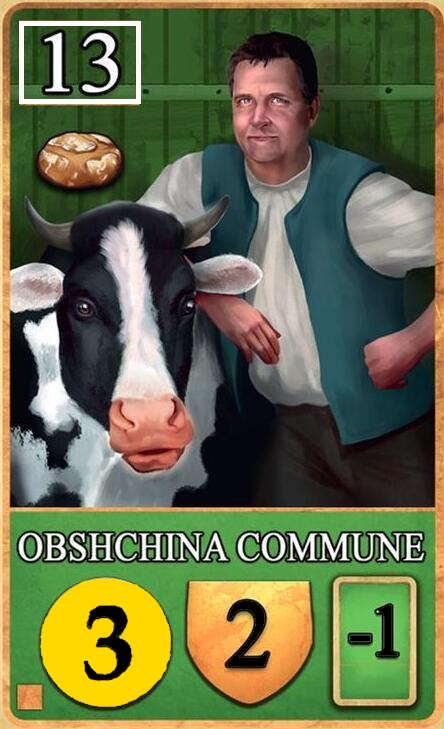
Obshchina Commune
This New Farmers trading card (with grain
symbol) is -1 towards the cost to purchase Worker or Worker trading
cards (but not itself).


New Society (1st edition)/ October revolution (2nd edition)
is a trading card that can be bought using any worker card.
Note: The 2nd edition card does not have any worker symbols, and thus does not provide a bonus for the textile factory.

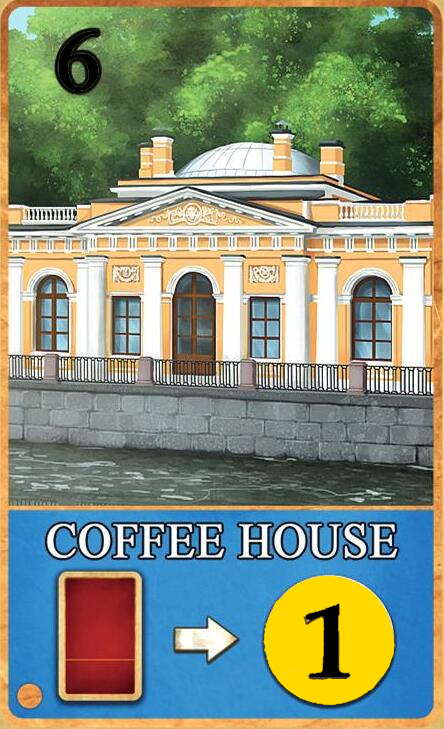
Coffee House
earns 1 ruble for each aristocrat and aristocrat trading
card in your tableau during the building scoring (whether these
are distinct or not). Note that this building can be later upgraded.

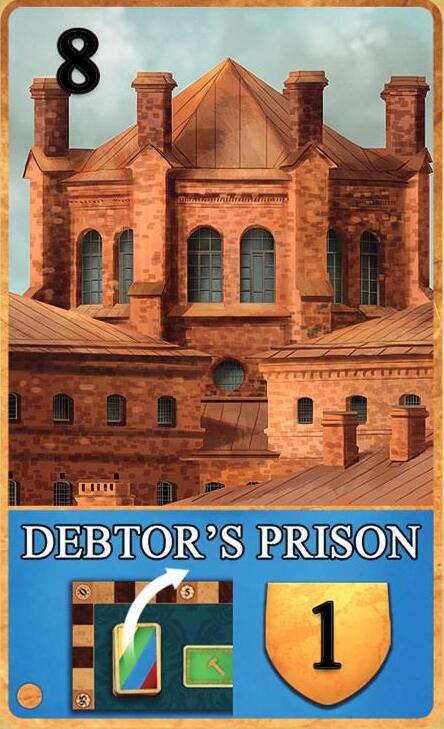
Debtor's Prison
either score 1 VP or, as an action during the building
phase, search the discard pile and take any 1 card from it, which then must
be paid for or put into your hand (discard if your hand is full). Flip the Debtor's
Prison face down after taking a discard card; it may not be upgraded to a
building trading card until it is flipped face up following the building phase.

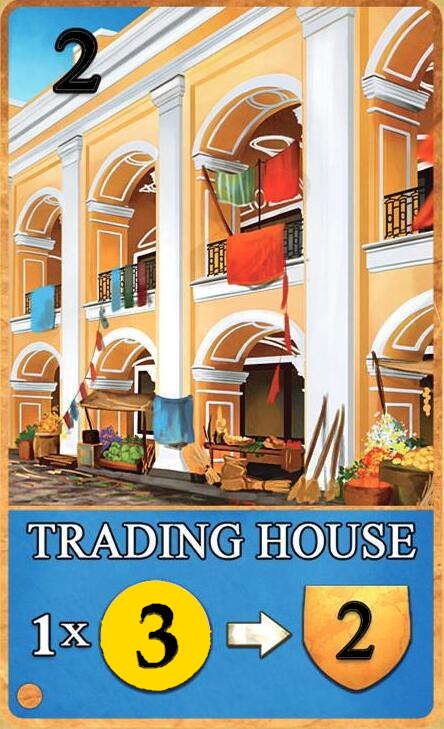
Trading House
After each building scoring, you
can pay 3 rubles to the bank and score 2 victory points.
Unlike the pub, you can only use this ability once per
round.

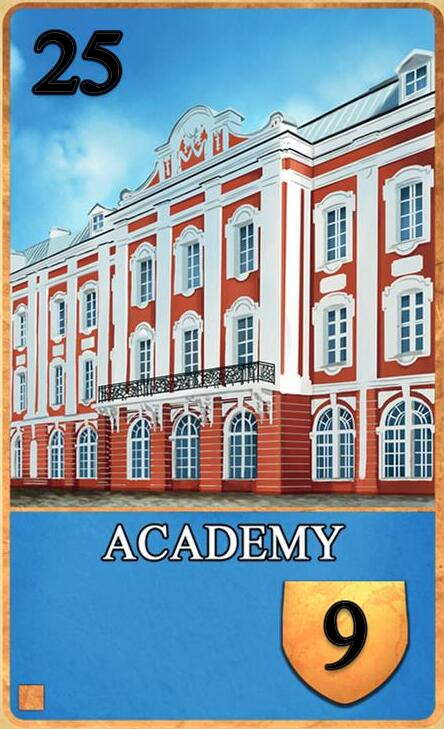
Academy
costs more (25) and scores 9 victory points!

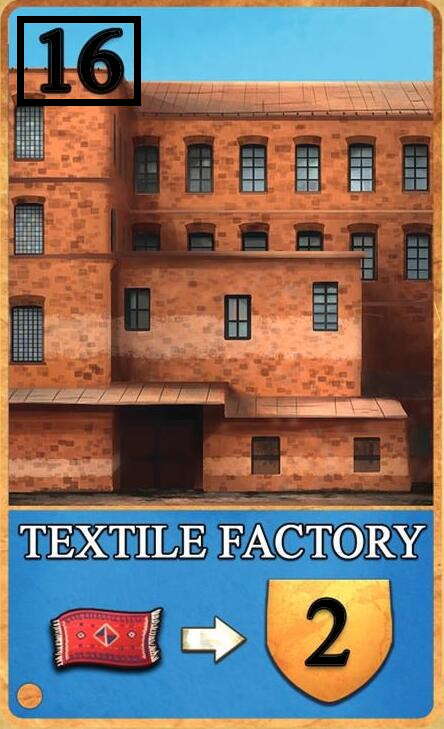
Textile Factory
this building trading card earns 2 victory points for each
card with a weaving symbol in your tableau (i.e. Shepherds, Weaving Mills,
the Czar & Carpenter, and the New Society, but not the Textile Factory itself).

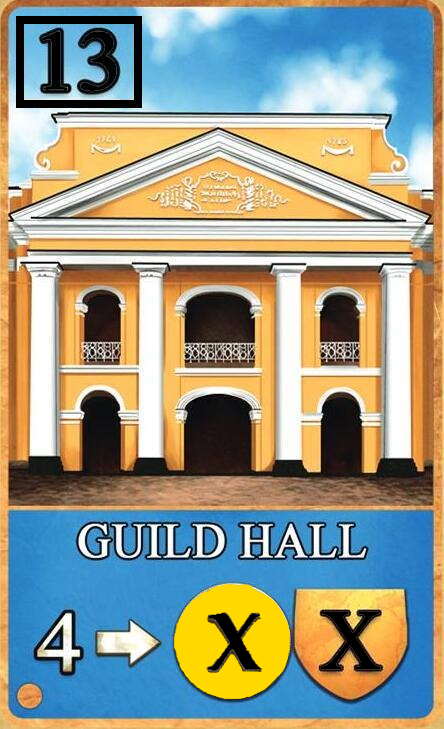
Guild Hall
this building trading card is flexible, earn four rubles or
victory points in any combination (such as three rubles and one victory
point or no rubles and four victory points) when scoring buildings.

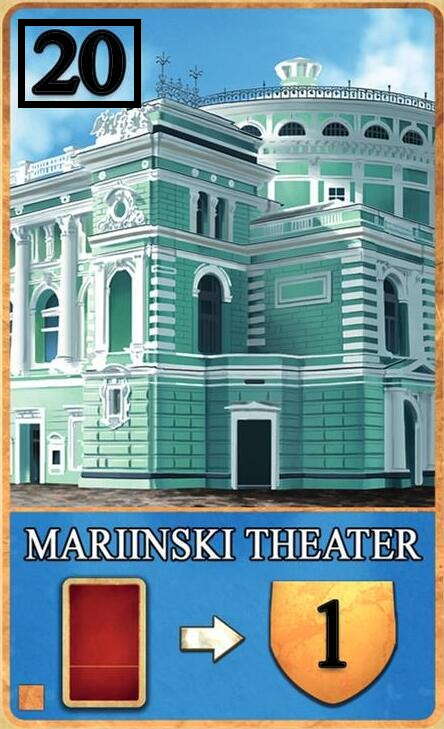
Mariinski Theater
now scores 1 victory point for each aristocrat
and aristocrat trading card in your tableau (whether these aristocrats are
distinct or not) when scoring buildings.


Observatory
now costs 8 rubles.


Sycophant
this new aristocrat costs only 1 to put into play, but has -1
income during the aristocrat scoring phase (discard it if you cannot
pay for it after scoring your other aristocrats).


Mayor
this aristocrat trading card earns 1 ruble for each building and
building trading card in your tableau during the aristocrat scoring.


Mistress of Ceremonies
now scores 3 rubles and 4 points.
All "New Society 1st edition" rules apply. Module 2 (In Good Company) must be chosen.
This expansion can be combined with the market and all 6 modules.
A 5 - player game
For a 5 player game with the market the market rules apply for 5 players.
5 player games without market are handled as follows:
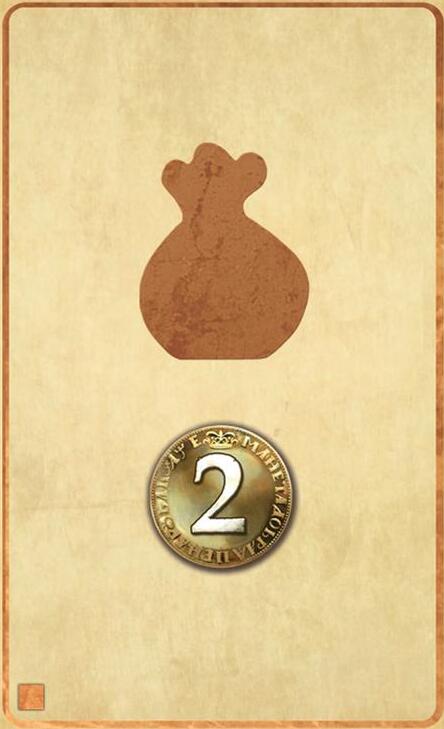
Use the new symbol card along with the four start cards from the base game.
The player with the sack gets 2 extra rubles at the start of the game.
At the beginning of each worker phase, give the player with the sack 2 victory points.

Each player passes their wooden piece to the player two places to the left
instead of to their immediate left-hand neighbor.
All "New Society 1st edition" rules apply. Module 2 (In Good Company) must be chosen.
Along with the new cards the expansion of the 2nd edition contains material
to play the game with 5 players
This expansion can only be played with the base Saint Petersburg game and optional Module 1!
This expansion cannot be combined with "The New St. Petersburg market"!
Clarification: Game publishers have agreed to remove these two sentences and replace them with the following.
This expansion can be combined with the market and all 6 modules.
A 5 - player game
For a 5 player game with the market the market rules apply for 5 players.
5 player games without market are handled as follows:

Use the new symbol card along with the four start cards from the base game.
Give each player a start card and then trade the cards in for the corresponding wooden pieces.
Give the player with the sack 2 extra rubles only at the start of the game (i.e. 27 rubles total).
The player with the sack is never the start player. At the beginning of each worker phase, give the player with the sack 2 victory points.
During the very first worker phase, draw and add 10 worker cards to the game board.
In all subsequent rounds of the game (including subsequent worker phases), add enough cards to bring the
total up to 8 cards as usual.

At the end of a round, after the upgrade phase, move all remaining cards as usual
to the second row on the game board.
Each player passes their wooden piece to the player two places to the left
instead of to their immediate left-hand neighbor.
We see the new Saint Petersburg as an expanded version of the base game. We suggest playing
this version of the game as soon as you know the base game well. The Market offers more tactical and strategic
options, which offer new challenges for players.
Game Components
25 wooden markers (5 per player)
1 wooden piece (sack): 
35 market cards (yellow)
Setup
1. Place the market value tiles in a pile
on the corresponding space on the
game board. Sort the tiles in increasing
order and make sure the lowest-value
tile  is on top of the pile and
the highest-value tile is on top of the pile and
the highest-value tile  on the
bottom. on the
bottom.
2. Distribute the symbol cards as follows:
-
In a 5-player game, randomly deal each player 1 card.
-
In a 4-player game, randomly deal each player 1 card.
Give the last card to a player chosen at random.
-
In a 3-player game, randomly deal each player 1 card.
Give an additional card to two players chosen at random.
-
In a 2-player card, randomly deal 2 cards to each player.
Give the last card to a player chosen at random.
Players now trade their symbol card(s) in for the corresponding
wooden piece(s).
Gameplay
The game is played in the same way as the base game with the following changes:
In a 5-player game, deal 10 worker cards out during the very first worker phase, in
all subsequent rounds the tableau is refilled to a total of 10 cards independent of
player count.
New phase between worker and building phase: the market phase.
The game is played in the same way as the base game with the following changes:
In a 5-player game, deal 10 worker cards out during the very first worker phase.
In 4-, 3-, or 2-player games the number of worker cards dealt out during the very first worker phase remains
unchanged.
In all subsequent rounds, the administrator refills the tableau to a total of 10 cards. This is independent of the
number of players!
A new phase is played between the worker phase and the building phase: the market phase.
The Market Phase
Each round, players are rewarded for selling goods at the
market.
There are 5 different market symbols and one  symbol which are located in the upper
right hand corner of the cards. Market
symbols can also be found on some of the cards from other phases.
symbol which are located in the upper
right hand corner of the cards. Market
symbols can also be found on some of the cards from other phases.






Whenever you buy a card with 1 or more market symbols on it, track the symbols in
the market.
You only score market victory
points during market scoring.
Wooden markers are not removed after scoring!
(Exception: the orange market cards, see here.)
Note: If a player replaces a card bearing one or more market symbols with an exchange card, this loss of market symbols
must be tracked.
Players continue taking turns until all have passed in turn. Scoring of market cards and
the market itself follows.
 Each round, players are rewarded for selling goods at the
market. The market symbols are important for this. There are 5 different symbols and 1 ? symbol:
These are located in the upper
right hand corner of the cards. Each yellow market card has 1 to 3 market symbols of a single type. Market
symbols can also be found on some of the workers, buildings, or building exchange cards.
Each round, players are rewarded for selling goods at the
market. The market symbols are important for this. There are 5 different symbols and 1 ? symbol:
These are located in the upper
right hand corner of the cards. Each yellow market card has 1 to 3 market symbols of a single type. Market
symbols can also be found on some of the workers, buildings, or building exchange cards.
Whenever you buy a card with 1 or more market symbols on it and place it in front of yourself, track the symbols in
the market. Each player has 5 wooden markers, one for each symbol. Move the appropriate marker as many spaces
forward as the number of symbols on the card.
You only score market victory
points during market scoring which is further explained here.
Even when you buy other, non-yellow,
cards that affect the market, you will only score victory points for those
symbols at the end of the market phase. Wooden markers are not
removed after scoring! (Exception: the orange market cards, see here.)
Note: If a player replaces a card bearing one or more market symbols with an exchange card, he must modify
the corresponding market marker to reflect this loss of market symbols. Players must take care to ensure that their
market markers accurately reflect the market symbols they currently possess.
Players continue taking turns until all have passed in turn. Scoring of market cards and
the market itself follows.
At the end of a round, the market value increases. Return the topmost market value tile to the box; the next higher
market value will be in effect during the next round.
Once the highest market value tile  is revealed, then the market value will not change for the rest of the game. is revealed, then the market value will not change for the rest of the game.
Scoring at the end of a market phase
There are two types of scoring at the end of a market phase:
1. Scoring individual market cards
Players receive as many rubles from the bank as their cards are worth.
2. Scoring the market
The market is scored according to the current market value tile.
Each market symbol is scored separately. For each symbol, the player
with the most of that type of good scores the higher
victory point value. The second place player scores the lower value, and the
remaining players score nothing for that symbol.
Tie: If two players are tied for the most goods, both players score for
first place and second place is not scored. If two players are tied for the second-most
goods, both players score for second place.
There are always two types of scoring at the end of a market phase. First, the players’ individual market cards are
scored, followed by the market itself.
1. Scoring individual market cards
Market cards are worth between 0 and 2 rubles. Players receive as many rubles from the bank as their cards are worth.
2. Scoring the market
When scoring the market, pay attention to the current value of the market. The market value increases over the course
of the game, which means that players score the fewest victory points during the first rounds. The current market
value is always visible at the top of the market. Each market symbol is scored separately. For each symbol, the player
who brought the most of that type of good to the market (i.e. whose marker is the furthest ahead) scores the higher
victory point value. The second place player scores the lower victory point value. The
remaining players score nothing for that symbol.
Tie: If two players are tied for the most goods of one type, then both players score for
first place and second place is not scored. If two players are tied for the second-most
goods of one type, then both players score for second place. First place scores as usual.
Example: At the end of the market phase, the market looks like this and the market value is: 

Chicken: Yellow player has the most chickens and scores 3 victory points. Blue and
red each score 1 victory point despite being tied.
Grain: Red scores 3 victory points. There is no second place for grain.
Apples: Green scores 3 victory points. There is no second place for fruit.
Fish: Black scores 3 victory points. There is no second place for fish.
Cabbages: Blue scores 3 victory points and black scores 1 victory point for
vegetables. Red scores nothing.
Overall, red, blue, and black each scored 4 victory points. Yellow and green scored 3 victory points.
Exception: the  symbol symbol
Each of the five market card types has 1 orange special card. When you buy one of these, you first pay
1 ruble and move your corresponding wooden marker 4 spaces ahead. After individual market card scoring
but before the market itself is scored,
you must pay the upkeep for the card in rubles equal to the current market value (the higher number)
if you want to keep the card.
If you do not pay the upkeep, you move your wooden marker 4 spaces back and score for its new position.
The orange card is discarded.
Exchanging cards with market symbols: When you replace one of your cards with an exchange card, you must also
adjust the position of the corresponding wooden marker in the market. This way it is always easy to tell each player’s
relative position in the market.
Clarification: The market symbol token (that replaced the '?') goes back to the supply.
Each of the five market card types has 1 orange special card. This is an exception. When you buy one of the special
cards, you first pay 1 ruble and move your corresponding wooden marker 4 spaces ahead. Before each market scoring,
you must pay the upkeep for the card.
Upkeep: You must pay rubles equal to the current market value (the higher number).
Clarification: If several players have orange special cards, they make decisions starting with the one holding the starting player
marker of the market phase and proceeding clockwise.
If you pay the upkeep: Pay the upkeep to the bank . Leave your wooden marker where it is
and score for it. Keep the orange card in front of you. During the next round, you will need to pay upkeep
during market scoring again.
If you do not pay the upkeep: Move your wooden marker 4 spaces back and score for its new position.
Add the orange card to the discard pile.
Each round, you must pay upkeep for each of your orange cards after individual market card scoring but before the
market itself is scored. You must pay the higher current market value for each of your orange cards.
When you replace one of your cards having market symbols with an exchange card, you must also
adjust the position of the corresponding wooden marker in the market. This way it is always easy to tell each player’s
relative position in the market.
Clarification: The market symbol token (that replaced the '?') goes back to the supply.
The Modules
Module 1: The Banquet
Module 2: In Good Company
Module 3: The Assistants (only playable when using "The Market")
Module 4: The Events (only playable when using "The Market")
Module 5: The Assignments (only playable when using "The Market")
Module 6: The Obstacles (only playable when using "The Market")
The module contains 15 cards: 3 normal cards and 12 special purple cards.
Shuffle all of the cards into the appropriate piles depending on their reverse sides. The special purple cards are typically free. They
must first be taken in hand, which means that you have to have room for them in your hand. If you want to use a purple card’s
special action, you do so in a later turn. You can only use a purple card if its special function can be carried out. They cannot simply
be discarded for no effect, but also do not reduce your score at the end of the game.
Once a special card has been played, remove it from the game.
Note: This module can also be used with the base game only. In that case, return these three yellow-backed cards to the
box: black market, money collector, and moocher.
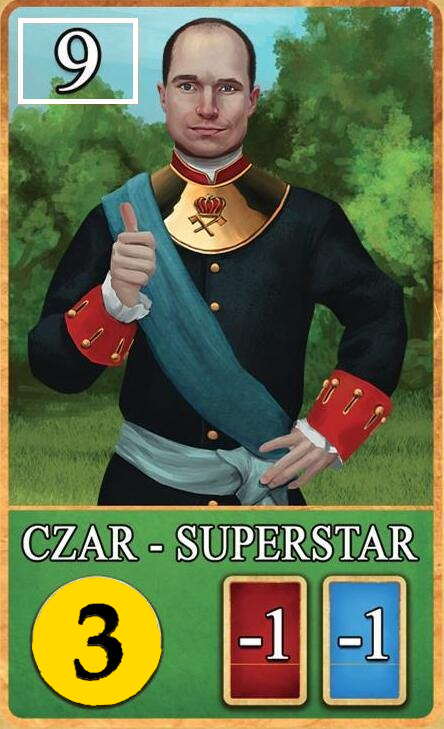
Czar - Superstar (1x)
This card can only be used to replace
the Czar & carpenter. You receive 3 rubles during worker scoring.
You also pay 1 ruble less for each blue or red card you buy
for the rest of the game (exchange cards included).
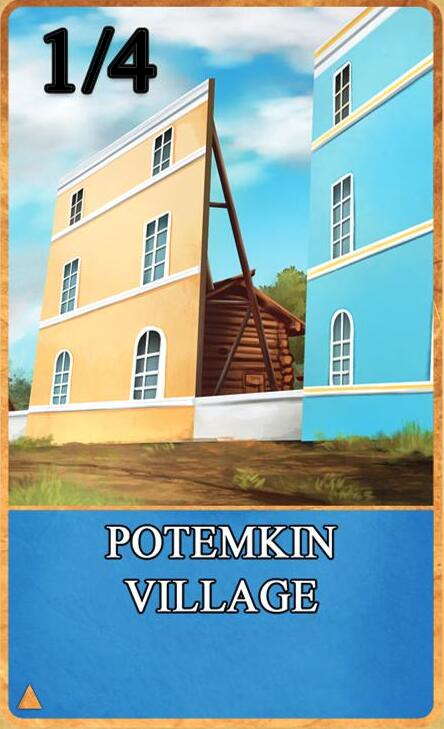
Potemkin Village 1/4 (1x)
Costs 1 ruble.
When you want to replace Potemkin Village
with another card, its cost is considered to
be 4 rubles. This means that you must pay
less to replace it than usual.
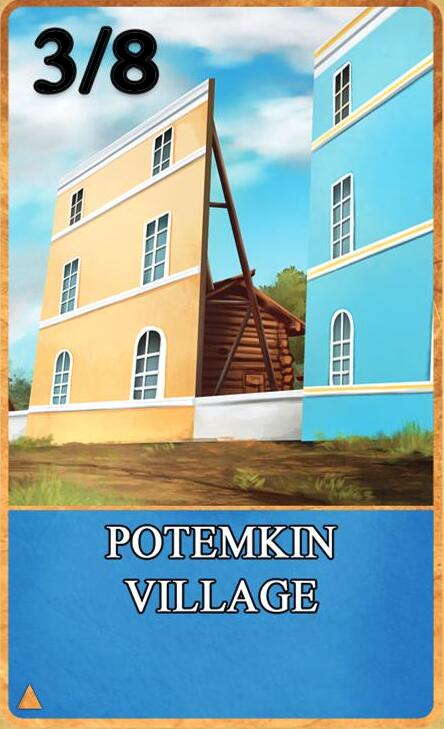
Potemkin Village 3/8 (1x)
Costs 3 rubles.
When you want to replace Potemkin Village
with another card, its cost is considered to
be 8 rubles. This means that you must pay
less to replace it than usual.
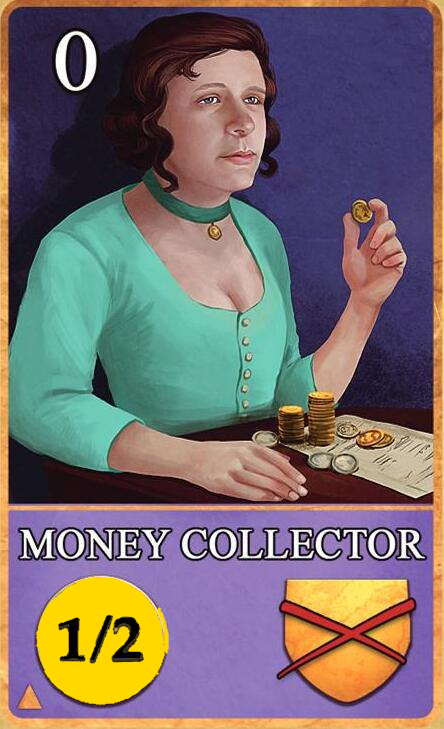
Money collector (1x)
Pay half of the cost
for a card and play it out in front of yourself.
Place the  chip on the card. You score no
victory points for the card and are not allowed
to replace it. chip on the card. You score no
victory points for the card and are not allowed
to replace it.
Clarification: First you apply the price reduction from other sources, then you pay half the price (rounded down).
Clarification: You can also buy a card that does not have any VP.
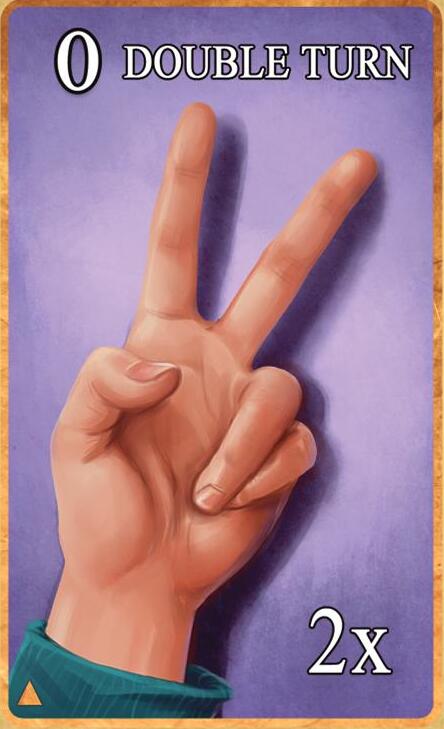
Double Turn (1×)
Immediately take 2 actions, one
after the other. Each of the two actions gives you the
choice of buying a card, taking a card in hand, playing a
card out from your hand, or passing.
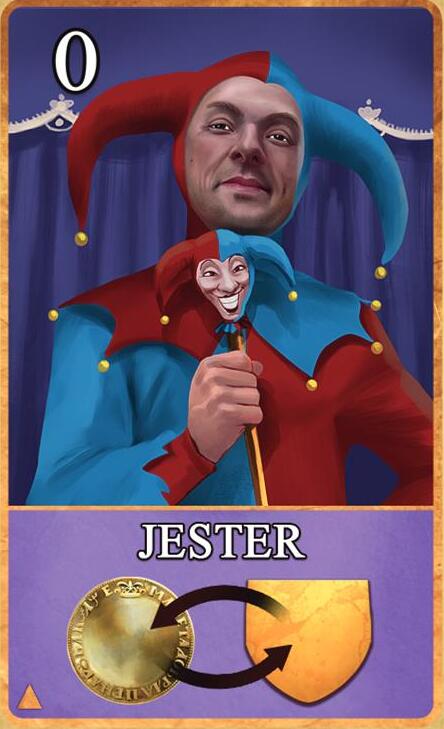
Jester (1×)
Assign the jester to one of the cards in your play area. The card
you choose must have a ruble and a victory point value. The next time that
card is scored, reverse the two values. In other words, receive rubles equal to
the card’s victory point value and victory points equal to the card’s ruble value.
After scoring, remove the jester from the game.
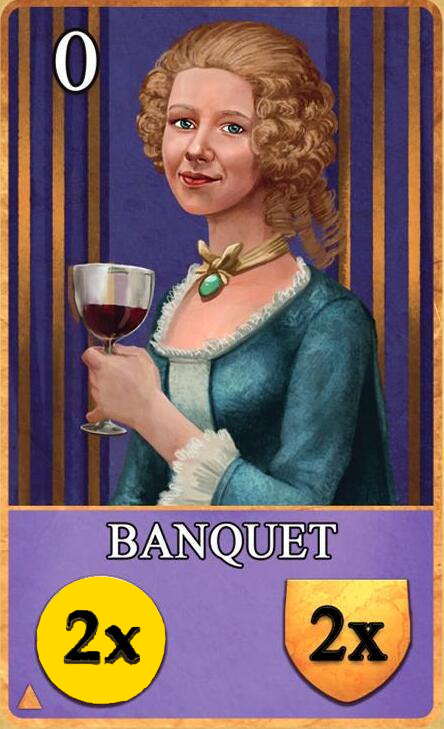
Banquet (1×)
Assign the banquet to one of the cards in your
play area. The card you choose must have a ruble and a victory
point value. The next time that card is scored, double the two
values. After scoring, remove the banquet from the game.

Pick Pocket (1×)
If you choose to play the pick pocket, you must play it at the start of a phase (i.e. when new
cards are added to the board). Using the pick pocket does not cost an action. If you played the pick pocket, you can
buy or take a card in hand from the board before the start player. The phase then continues, starting with whoever
the usual start player is and continuing with the other players in turn. The wooden pieces do not change hands.

Black Market (3×)
Choose 1 card from the discard
pile. You can either buy the card immediately, take it
in hand, or return it to the discard pile.
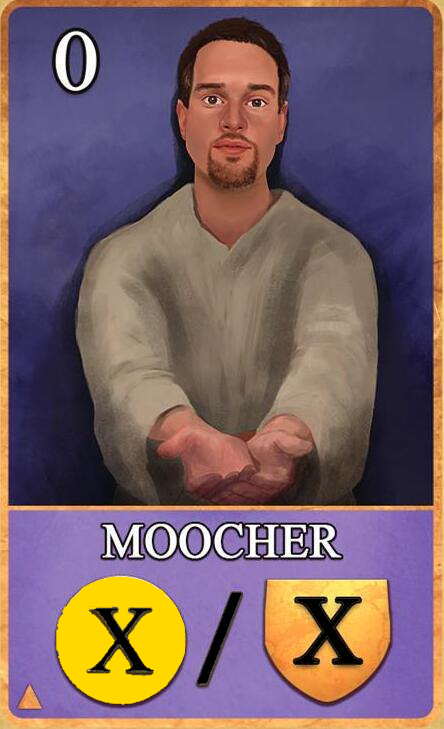
Moocher (1×)
Choose an opponent, then
choose a card in his play area. Immediately
score rubles or victory points for that card
Clarification: 1. If a chosen card depends on other cards, you take opponent's cards into account.
(e.g. using Moocher to choose opponent's Taxman would yield as much money as that opponent has workers.)
Clarification: 2. If a chosen card has Jester or Banquet assigned, the income is not affected and the chosen player does not discard Jester or Banquet.

Golden Donkey (1×)
Immediately
receive 5 rubles from
the bank.
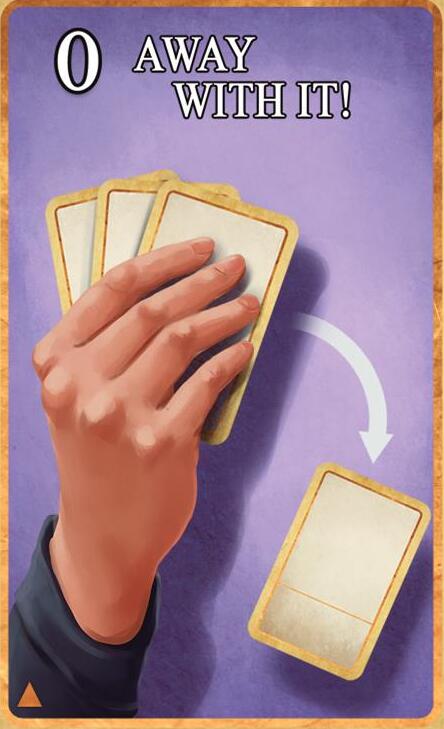
Away With It! (2×)
Choose
1 card from your hand and add
it to the discard pile.
Clarification: It is not allowed to discard the purple special cards.
This module includes 12 extra cards, which are shuffled into the game. You can also use only those cards from this expansion that
you want, leaving the rest in the box. Shuffle the cards into the appropriate piles depending on their reverse sides.
On yucate.de you can only choose to play with all 12 cards. You can't choose only some of them.
Note: If you play with both modules 1 and 2, do not include the debtor’s prison.
Note: Module 2 must be chosen when playing with the expansion "New Society", so the cards are described in more detail there.
The 12 cards are:
3 Buildings: Coffee House, Trading House, Debtor’s Prison.
2 Nobles: Sycophant (2×)
7 Exchange Cards: October Revolution, Textile Factory, Guild Hall, University, Merchant, Lt. Kijé, Mayor.
Content
5 Assistant Cards: Each assistant has their own unique attributes.
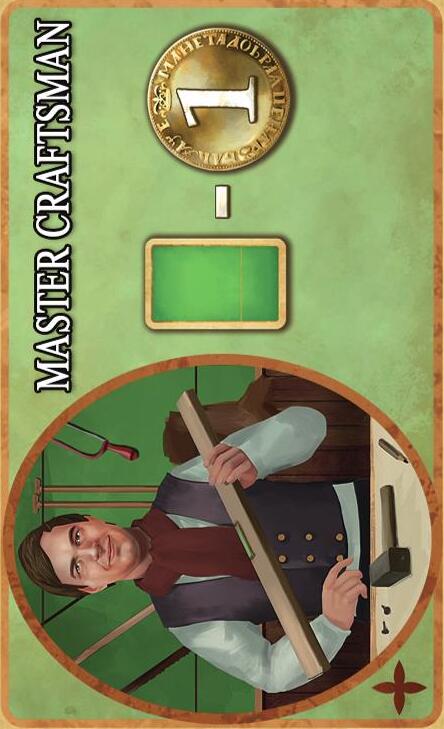
Master Craftsman
Buying green cards:
-1 ruble
If you have this
assistant, you pay
1 ruble less when
buying green cards.
This includes green
exchange cards.

Mistress of the Manor
Buying yellow cards:
-1 ruble
If you have this
assistant, you pay
1 ruble less when
buying yellow cards.

Architect
Buying blue cards:
-1 ruble
If you have this
assistant, you pay
1 ruble less when
buying blue cards.
This includes blue
exchange cards.

Lawyer
Buying red cards:
-1 ruble
If you have this
assistant, you pay
1 ruble less when
buying red cards. This
includes red exchange
cards.

Czar’s Daughter
Buying exchange
cards: -2 ruble
If you have this
assistant, you pay
2 rubles less when
buying exchange
cards
Setup
After having determined who the start player will be for each phase, assign 1 assistant to each player. The assistants to use depend
on the number of players, as described below (return all unused assistants to the box):
-
2-player game: Use the Architect (blue) and the Lawyer (red) only. Randomly deal one to each player.
-
3-player game: Use the Architect (blue), Lawyer (red), and Czar’s Daughter (multicolored). Randomly deal one to each player.
-
4-player game: Use the Architect (blue), Lawyer (red), Czar’s Daughter (multicolored), and Mistress of the Manor (yellow). Only
the Master Craftsman is returned to the box. Give the Mistress of the Manor to the player to the right of the player with the sack.
Randomly deal the remaining assistants to the remaining players.
-
5-player game: Use all 5 assistants. Give the Mistress of the Manor to the player to the right of the player with the sack. Give
the Master Craftsman to the player to the right of the player with the hammer. Randomly deal the remaining assistants to the
remaining players.
Gameplay
At the end of a round, after the exchange phase, pass the assistants counterclockwise, that is to the next player on the right.
Content
6 Event Cards:
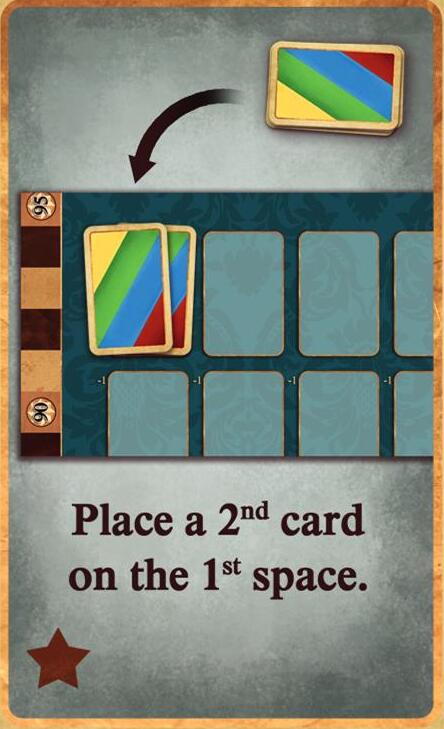
Twin
Add a second card to the upper left hand space of the tableau
(one card must already be there). There will now be 2 cards on that
space. Players must take both cards at the same time. You can buy
both of them, buy one and take the other into your hand, or take
both into your hand. You cannot keep one and discard the other.
Clarification: If after playing an event a player chooses some other action leaving both card untouched, then both cards are discarded.
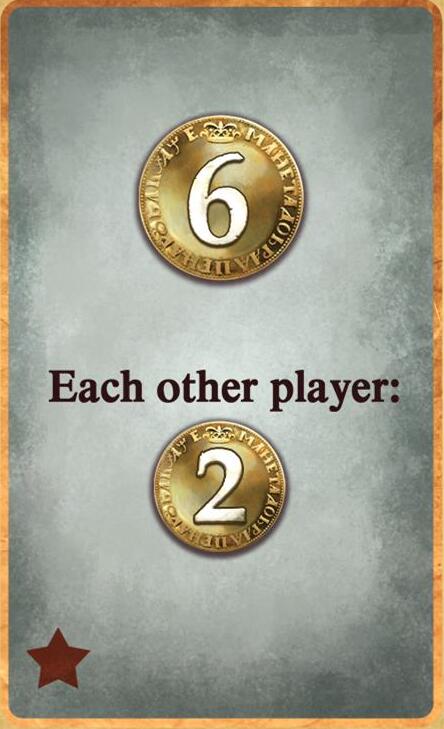
Sponsor
Receive 6 rubles
from the bank. Each other
player receives 2 rubles from
the bank.
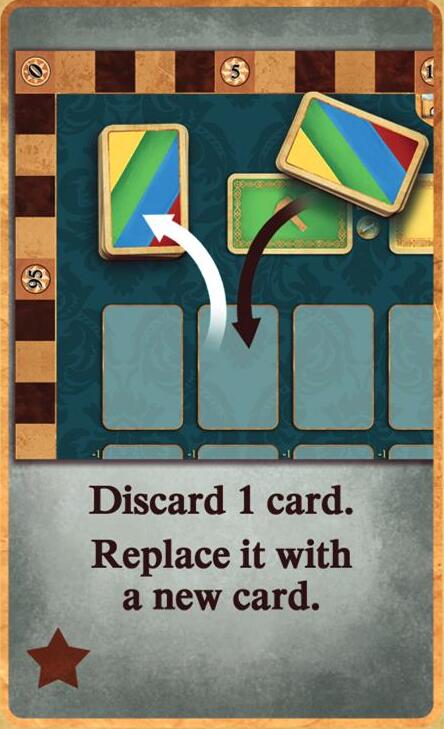
Ghost
Take one card from the
tableau and add it to the discard
pile. Replenish the card with a
new card from the current phase’s
draw pile.
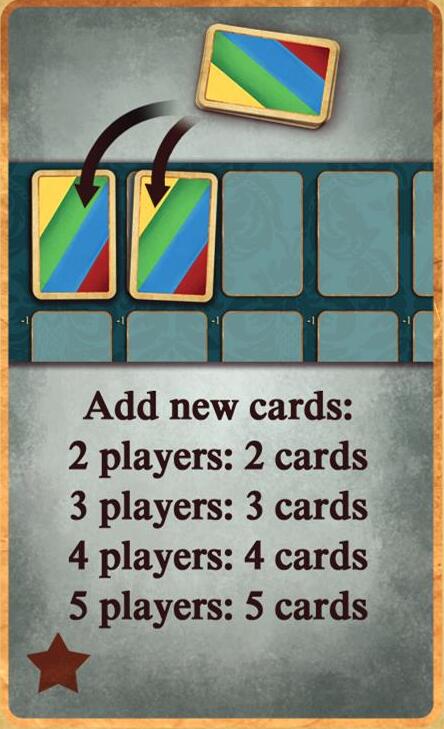
New Luck
Add as many cards from the current phase’s draw
pile to the tableau as there are players in the game. You can
only choose this event if there are enough empty spaces on the
board! As usual you can only add cards to the first row on the
board
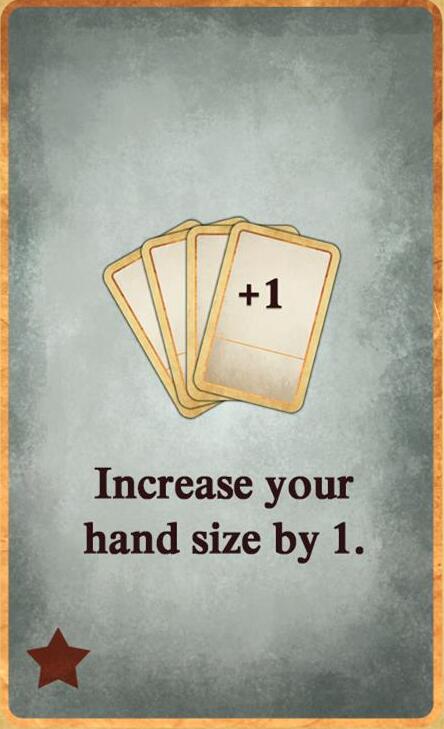
Warehouse
Play this card in front of yourself in your play area.
Your hand size is immediately increased by 1.
Note: This warehouse is not a blue card. You cannot replace it and
it does not reduce the cost of any other cards.
If you have the blue warehouse also, then your hand size is 5 cards.

Grabber
You can buy the
topmost card in the discard pile.
You must pay for it immediately.
You then take your regular turn
Setup
The administrator places the 6 event cards next to the board at the start of the game.
Gameplay
Each event can only be used once during the game.
Events can only be triggered from the second round on!
Each player can only trigger one event. On your turn, before your usual turn, you can take 1 event card and carry the event
out. Each event is different. When doing so, place the card in front of yourself. This indicates that you have already triggered an
event. Then take your turn as normal.
Note: If you are using the Events module, then the way in which cards are added to the discard pile at the end of a round is
important. Clear the second row of the tableau from left to right, which means that the rightmost card becomes the topmost
card in the discard pile.
If you add more than 1 card to the discard pile during the game, you choose the order in which you discard the cards.
The selection of discard order is not implemented on yucata.de.
Content
15 Assignment Cards: Each assignment is different.
Setup and Gameplay
At the start of the game, deal 3 assignments to each player. Keep all 3 assignments until the end of the game and score the best one.
Note: The final scoring order at the end of the game is important, see "Final scoring order".

Score 2 victory points
for each of your red
cards.
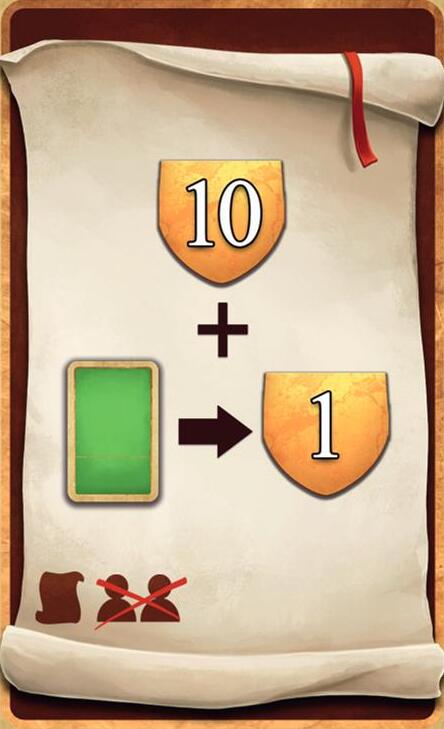
Score 10 victory points and
1 victory point for each of
your green cards.
Remove this card in a
2-player gamer!
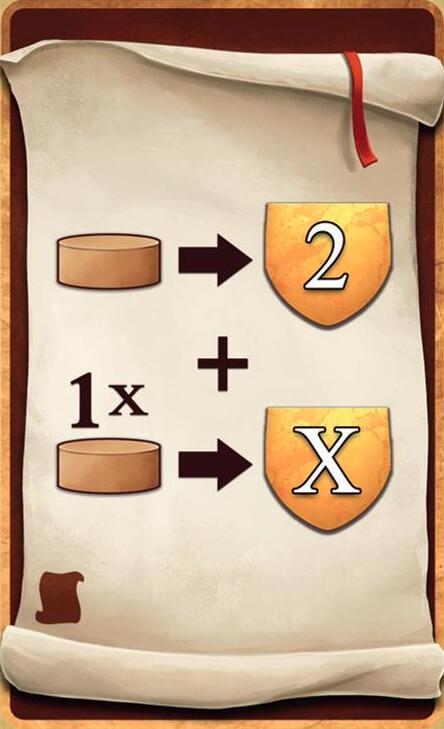
Score 2 victory points for each
wooden marker you have in
the market. Score additional
victory points for the position
in the market of one of your
markers
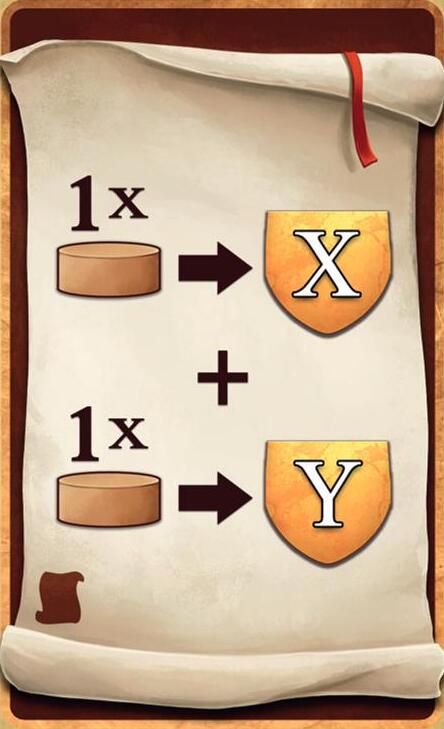
Choose 2 of your wooden
markers in the market.
Add their positions together
and score that many victory
points.

Score 3 victory
points for each of
your markets, customs
houses, and firehouses.

Score 10 victory points. Score
another 10 victory points if you
have the most rubles at the end
of the game (before players return
money for points).
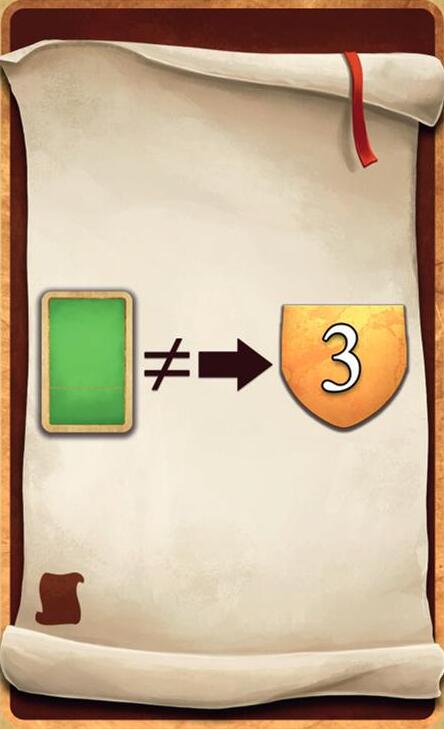
Score 3 victory
points for each
different green
card you have.
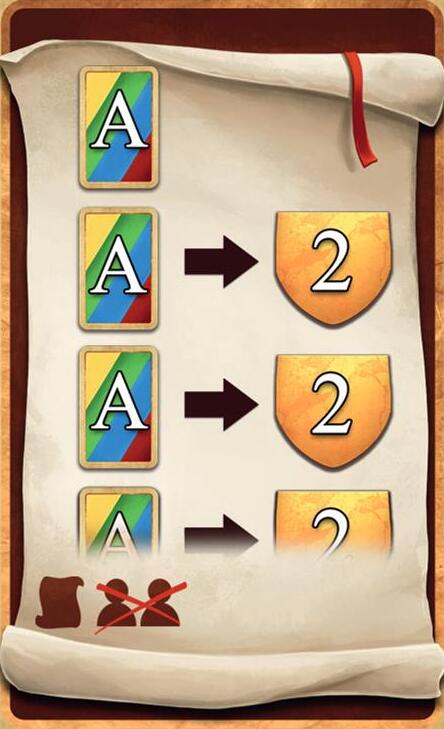
Score 2 victory points for each
identical card you have. This counts
from the second card. You do not score
any points for the first card. Remove
this card in a 2-player game!

Score 2 victory points
for each of your
exchange cards.

Score quadruple
the victory points
for your best red
card.

Score triple the
victory points for
your best blue
card.
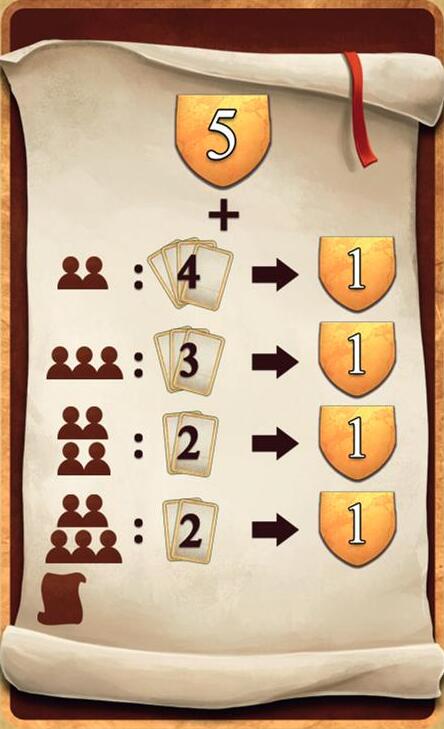
Score 5 victory points and then score additional
victory points depending on the number of players:
2 players: 1 victory point for every 4 of your cards
3 players: 1 victory point for every 3 of your cards
4-5 players: 1 victory point for every 2 of your cards

Score 2 victory
points for each of
your yellow cards.
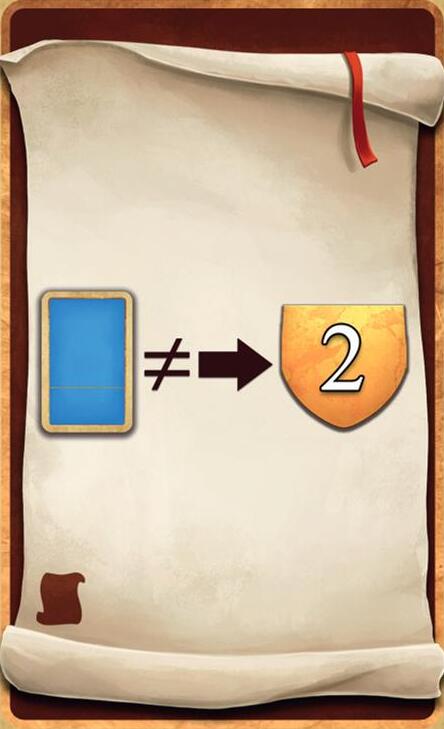
Score 2 victory points
for each different blue
card you have.
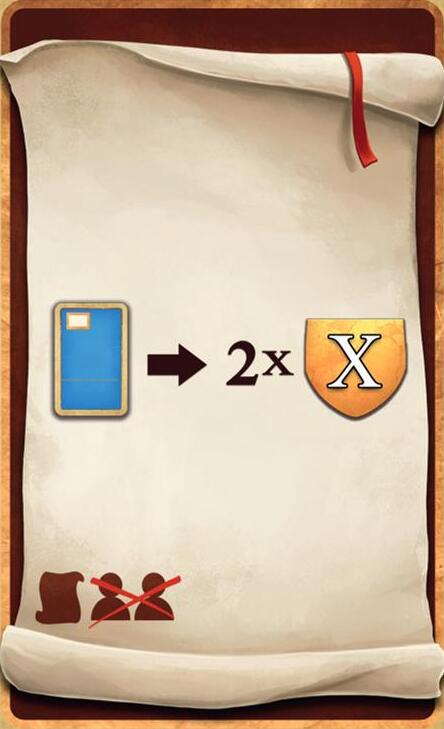
Score double victory points for
each of your blue exchange cards.
Remove this card in a 2-player
game!
Content
10 obstacles, divided into 2 categories. There are bonus obstacles and real obstacles.
The 5 bonus obstacles
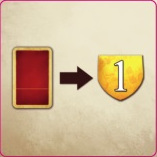
Bonus aristocrat obstacle
Receive 1 victory
point for each red
card in your play
area.

Bonus buildings obstacle
Receive 1 ruble
for each blue
card in your play
area.
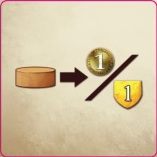
Bonus market obstacle
For each wooden marker you have in the
market, choose to receive either 1 ruble or
1 victory point. If you have no markers in
the market, you receive nothing.
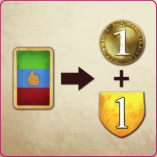
Bonus exchange obstacle
Receive 1 victory point and
1 ruble for each exchange
card you have in your play
area.
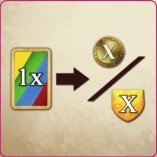
Bonus card obstacle
You must choose to receive either the ruble value of a card in
rubles or the victory point value of a card in victory points.
If you choose the Mistress of Ceremonies, for example, you can
choose to receive either 6 rubles or 3 victory points.
The 5 real obstacles:
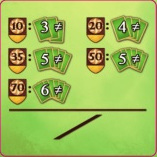
Real workers obstacle
You must have a certain number of
different green cards.
Space 10 of the score track: At least
3 different green cards.
Space 20: At least 4
Space 35: At least 5
Space 50: At least 5
Space 70: At least 6
Bonus: None

Real market obstacle
You must have a certain number of different wooden markers
in the market.
Space 10 of the score track: At least 2 wooden
markers in the market with at least one on position 3 or higher.
Space 20: At least 3 wooden markers with at least one on
position 4 or higher
Space 35: At least 4 wooden markers with at least one on
position 5 or higher
Space 50: At least 5 wooden markers with at least one on
position 6 or higher
Space 70: At least 5 wooden markers with at least one on
position 7 or higher
Bonus: Score 1 victory point per your own marker in the market
and choose one of those and gain its position in rubles.
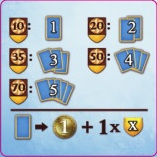
Real buildings obstacle
You must have a certain number of blue cards.
Space 10 of the score track: At least 1 blue card.
Space 20: At least 2
Space 35: At least 3
Space 50: At least 4
Space 70: At least 5
Bonus: Receive 1 ruble for each blue card in
your play area and score victory points for 1 of
your blue cards
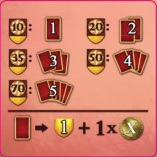
Real aristocrats obstacle
You must have a certain number of red cards.
Space 10 of the score track: At least 1 red card.
Space 20: At least 2
Space 35: At least 3
Space 50: At least 4
Space 70: At least 5
Bonus: Score 1 victory point for each red card
in your play area and receive rubles for 1 of
your red cards.
Clarification: If Sycophant is the only aristocrat the player has, he/she does not have to pay anything (receives 0 rubles, not -1).
Because overcoming real obstacle should give a bonus, not a cost.
Game designer implemented this exception because of the problem described here:
SaintPetersburg2/13158368 bug
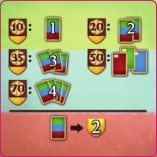
Real exchange obstacle
You must have a certain number of exchange cards.
Space 10 of the score track: At least 1 exchange card.
Space 20: At least 2
Space 35: At least 3
Space 50: At least 1 green, 1 red, and 1 blue exchange card
Space 70: At least 4
Bonus: Score 2 victory points for each exchange card in your
play area.
Setup
Use 5 obstacles in a game.
At the start of the game, randomly choose 3 bonus obstacles and 2 real obstacles. Return the remaining
unused obstacles to the box.
Add the obstacles along the score track. Randomly place one real obstacle each at 20 and 35 victory
points. Randomly place one bonus obstacle each at 10, 50, and 70 points.
Gameplay
-
As soon as your scoring marker lands on or passes a space with a bonus obstacle, you receive the corresponding bonus.
-
As soon as your scoring marker lands on or passes a space with a real obstacle, you must check to see if you can overcome
the obstacle:
-
Obstacle overcome: You can pass over the obstacle. You also receive the obstacle’s bonus, should one exist. If you score additional
victory points, your scoring figure is moved ahead as usual.
-
Obstacle not overcome: Your scoring figure stays put in front of the obstacle (any additional victory points are lost). You can
only continue to score victory points once you have overcome the obstacle.
Note: Obstacles also count during final scoring! In other words, obstacles continue to block scoring until the end of the game. If
you get stuck in front of an obstacle during the game and cannot overcome it before the game ends, you will also not score anything
during final scoring!
Note: The final scoring order at the end of the game is important, see below.
Variant
Experienced players can choose to play with a different combination or number of bonus and real obstacles. You can choose to play
with 0 to 5 real obstacles, adding 0 to 5 bonus obstacles to them. You can also vary which obstacles get assigned to which of the 5
spaces on the score track (10, 20, 35, 50, 70). Shuffle the obstacle tiles face down and randomly place them on the score track.
Note: On yucata.de it is not possible to choose obstacle locations. Those are always at 10, 20, 35, 50, 70 points.
Note: Players should pay close attention to the real obstacles from the start of the game, as they have great influence on the game
depending on where they end up on the score track. The later they come up, the harder they are to overcome. This is especially
true for the green obstacle, the yellow obstacle, and the exchange obstacle. The real obstacles are intended as a challenge for
experienced players as they force players to make tactical decisions based on their requirements.
With higher player counts (4 or 5 players), it is entirely possible that a player cannot overcome an obstacle through no fault of
their own. That will usually depend on how many exchange cards enter the game, and when.
The final scoring order at the end of the game can be important when players combine multiple modules.
Carry out final scoring in the following order:
-
Players receive victory points for their different nobles according to the table on the board.
-
Players receive victory points for their assignment. This only occurs when playing with module 5.
-
Players score 1 victory point for every 10 rubles they have left.
Clarification: If it is useless to transform rubles because the player is blocked by an obstacle, you do not transform rubles for victory points.
-
Players lose 5 points for every card left in hand.
Note: When playing with module 6, then the obstacles are also in effect during final scoring. If your scoring figure reaches or
passes a obstacle, resolve the obstacle in the same way you would during the game. The obstacles are part of final scoring and are
therefore in effect until the end of the game. If you cannot overcome an obstacle, then you remain stuck and cannot score any
more victory points.
Note: If the obstacle that requires decision (Bonus market obstacle or Bonus card obstacle) is overcome during final scoring
then the decision is processed automatically such that it would yield the most points (if a player would be blocked blocked by obstacle, rubles are
chosen, if possible).
Money and cards are visible to all players. The reason for this is that games often take days or weeks on yucata.de.
No one can remember what the others took in their rounds, especially not when you play several games at once. Some players
would write down this important information. Because of this we are making this information public. This also strengthens
the strategic aspect of the game.
In addition to that it is possible to see which cards are remaining in each of the hidden stacks of cards.
The cards are obviously not shown in the order in which
they are in the stack.
There are 3 buttons available at the bottom of the screen: Pass; Pass until board changes; Pass phase.
Pass - you skip your turn.
Pass until board changes - you Pass until any opponent takes/buys a card from the board or
plays any event except "Warehouse".
Pass phase - you have the option to pass until the end of the action phase; just click the "Pass phase" button,
then your next turn will be in the next action phase.
The selection for the guild hall can be done during the building action phase:
the chosen combination of rubles and points will be displayed (this is initially set to 4 points).
If nothing is selected in the building action phase, the last chosen combination is used for scoring.
The trading house can be used once during the building action phase.
The sycophant can be discarded during the aristocrat action phase. If during aristocrat scoring the money will
be reduced to a negative value, the sycophant is discarded automatically to prevent this.
You can click white bubbles on cardbacks to display talon (stack) and hidden cards of opponents of that type.
White bubbles on assignments are not clickable, they just display how many points an assignment would score.
If two cards need to be displayed in one cell (as a result of Twin event played, or Jester, or Banquet) the last card is displayed in smaller size on top of the fist card.
Clicking the smaller card shows both cards.
Phase scoring of money and points is represented by equation A + B = C (e.g. 1 + 2 = 3). Here A - amount before scoring; B - amount gained; C - amount after scoring.
Each obstacle has player status symbol in player color and some information displayed.
Possible statuses are:
Κ - Obstacle is not overcome, the player is still approaching obstacle.
∅ - Obstacle is not overcome, the player is sitting on obstacle location and is wasting points.
> - Obstacle is overcome, the player is still approaching obstacle.
+ - Obstacle is overcome and passed.
If obstacle is not passed, the information string shows player's progress in achieving goal. Each obstacle requirement has format {score}/{requirement}.
E.g. "1/5" near real worker obstacle would mean that player has 1 worker out of 5 required.
If obstacle is passed (status is "+"), the information string shows a bonus the player received for overcoming the obstacle.
Clicking the ∑ button displays a summary table. It has two header rows and stats for each player. The top header row shows the stat's type: worker income, market income, market upkeep,
buildings income, aristocrats income, the sum of all income, end game points received for distinct aristocrats. The bottom header row shows if it is money or point stat.
The last two columns show some cards of a player: special cards bought and cards on hand.
Notes:
Summary table is recalculated after all actions are performed, before the user clicks "Finish turn".
It is assumed that all players pay the upkeep for the orange cards when market upkeep and market point income is calculated.
Real obstacles are not taken into account. The summary table will show point income greater than zero even if the player is blocked by obstacle.
The game settings have a preference "Show images in log". The user can check this to display card images instead of clickable links in the game log.
The user needs to refresh the game window for the setting to take effect.
The game cards might become distorted on some monitor resolutions. The user should use aspect ratio to resolve this.
There are user preferences that allow the player to set aspect ratio for the game window. The preferences are:
Check box "Width is 100%"
Check box "Height is 100%"
Check box "Use aspect ratio"
Numeric field "Aspect ratio width:"
Numeric field "Aspect ratio height:"
The default behavior is to stretch the game window to 100% width and 100% height. That's why "Width is 100%" and "Height is 100%" are checked and "Use aspect ratio" is unchecked by default.
To use the aspect ratio the player has to set one dimension to 100% (not both, not none) and check "Use aspect ratio" and fill in the values of "Aspect ratio width" and
"Aspect ratio height". The user still might need to increase "Minimum window size (width x height in px)" if the game window goes offscreen.
| |